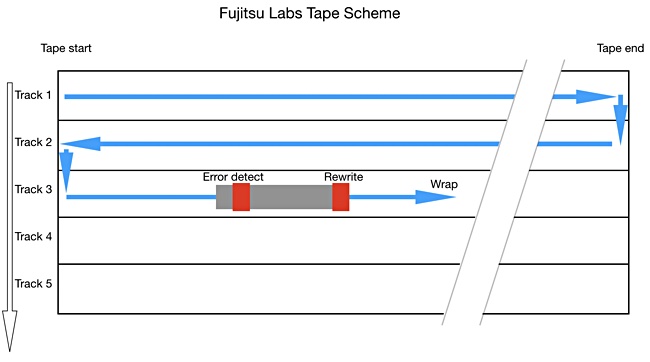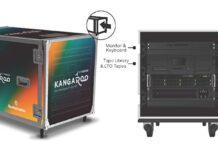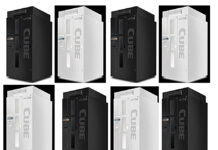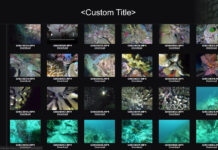Fujitsu Labs has accelerated LTFS tape read and write speeds by devising a multiple cartridge file system with faster directory access and by improving speeding file IO on cartridges.
LTFS, the Linear Tape File System, represents a tape drive that writes files sequentially as if it were a disk-based file:folder device, with files listed for random and not sequential access.
It uses an index stored on a tape cartridge and lists the cartridge’s contents as if they were in a file:folder structure. There is one LTFS directory (index) per tape cartridge and LTFS software in a server accessing a tape library reads a cartridge’s index and presents it in a file:folder format on screen.
Virtual Consolidated File System
In the new Fujitsu Labs scheme, modified LTFS software integrates multiple tape cartridges in a single filesystem/directory, a virtual consolidated file system (VCFS). This makes finding files in a tape library faster.

Block & Files has been told by Fujitsu Labs that the LTFS software server caches multi-cartridge file metadata and using it for locating and accessing files on individual tapes. This saves time as the file index is accessed without any tape read operations.
Fujitsu has added more enhancements to make tape file IO faster. The first is faster access to a file’s physical address on tape storage. Each file on tape has a logical address (e.g. file no 10 is after file no 9); the file write order; and a physical address that indicates a position on the tape. Files are written along tracks and there are multiple parallel tracks on a ribbon of tape. A tape drive read head looks at the parallel tracks as the tape passes underneath it.
When a tape cartridge is loaded int a tape drive, the tape steams from its start point to its end -point. It then reverses direction and streams the tape the opposite way. Data is written in so-called wrap units. A wrap runs along a track and then ‘wraps around’ as the tape reverses direction, with the data written in a parallel track to the starting or previous track.

Fujitsu Labs said the distance between the tape start and a file’s logical address (running along the track wraps) and a file’s physical address, running along the physical tape, are different. Its virtual consolidated file system accepts multiple random file read requests and processes them, starting not with the logical address but the closest physical location on the tape.
File end detection
When writing to tape, write and error checking are performed in parallel. When an error occurs, only the part of the error that occurred after the end of writing is automatically rewritten. The actual end of the file is therefore pushed further along the track. Fujitsu states that it is difficult to predict the physical location where a rewrite has finished from the change in file size.

Its file system periodically measures the head position after writing the file to better estimate the physical location (address) of each file.
Cross-tracking
The Fujitsu VCFS scheme processes random file read requests that are closest in physical address terms ands not necessarily in logical address terms. It can read files in different tracks, cross-tracking, rather than going sequentially along track 1 to its end, then track 2 to its end and so on, as a diagram shows;

This can save considerable time.
Multiple file aggregation
The VCFS concept also groups many small files into a single larger container file. That container file is written and read in single operations instead of the many individual operations that would be needed to read and write the individual smaller files within it. Fujitsu calls this a multiple file aggregation function, and again it save time.
Fujitsu Labs tested the time taken to randomly read 100 x 100MB files from a tape containing 50,000 individual 100MB files. Using LTFS the operation took 5,400 seconds. It was 4.2 times faster with VCFS, completing in 1,300 seconds.
VCFS was also quicker when writing 256 x 1MB files to tape, taking 1.3 secs; a 1.9x advantage. Conventional LTFS took 2.5secs.
Fujitsu Labs thinks VCFS will make tape storage more attractive as an archival medium. The scheme is undergoing verification testing and commercialisation is hoped to be complete by the end of Fujitsu’s fiscal 2022.
The company will present VCFS at the 12th online) Forum on Data Engineering and Information Management (DEIM 2020), March 2-March 4.







